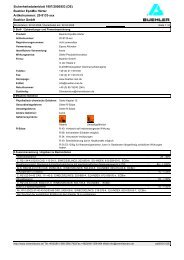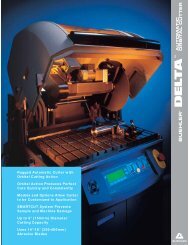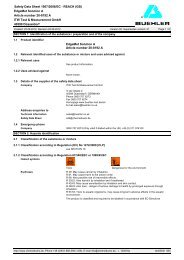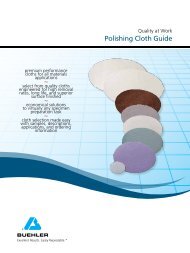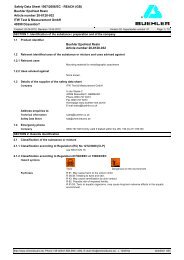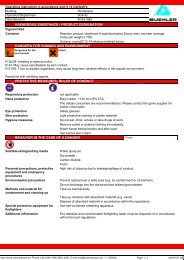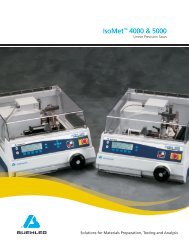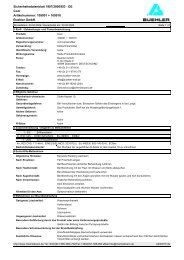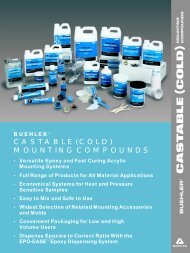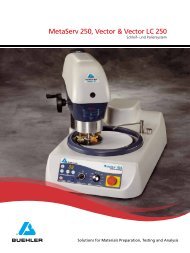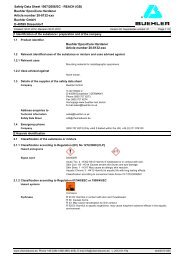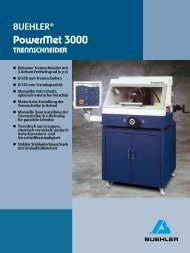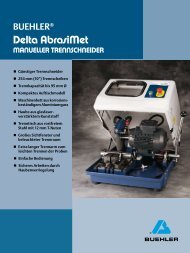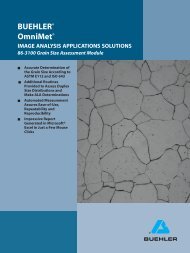BUEHLER Guide To Petrography - Department of Earth Sciences
BUEHLER Guide To Petrography - Department of Earth Sciences
BUEHLER Guide To Petrography - Department of Earth Sciences
You also want an ePaper? Increase the reach of your titles
YUMPU automatically turns print PDFs into web optimized ePapers that Google loves.
<strong>BUEHLER</strong> ®<br />
<strong>Guide</strong> to <strong>Petrography</strong><br />
Specimen Preparation<br />
Stages<br />
■ Sectioning Specimen<br />
■<br />
■<br />
■<br />
■<br />
■<br />
■<br />
■<br />
■<br />
■<br />
Impregnation &<br />
Encapsulation<br />
Trimming<br />
Surface Preparation Prior<br />
to Bonding<br />
Bonding<br />
Resectioning<br />
Grinding<br />
Polishing<br />
Microscopic Examination<br />
Image Analysis &<br />
Capture<br />
®
Introduction<br />
In 1849 when Henry Sorby, the father <strong>of</strong> petrography,<br />
prepared a thin section, he may<br />
not have envisioned that one day his technique<br />
would be used to analyze many<br />
diverse materials such as ceramics, glass,<br />
concrete, cement, soils, biomaterials,<br />
and polymers, to name a few. Sorby demonstrated<br />
to the scientific community that by<br />
using simple techniques, one could reveal<br />
the microstructure <strong>of</strong> materials observed<br />
with a microscope. Although Sorby’s method<br />
<strong>of</strong> preparation was crude compared to the<br />
methods used today, his basic technique for<br />
preparing and<br />
examining a specimen has remained fairly<br />
similar.<br />
There are two types <strong>of</strong> specimens routinely<br />
prepared for analysis, thin sections and<br />
polished bulk specimens. For polished bulk<br />
specimens, the surface is prepared for examination<br />
with a reflected light<br />
microscope. Thin sections, on the other hand,<br />
are extremely thin, generally 30µm or thinner,<br />
and are typically observed with a transmitted<br />
polarized light microscope. The chart<br />
to the right describes a general procedure<br />
required to prepare both thin sections and<br />
polished bulk specimens.<br />
Since 1936, Buehler has been the world<br />
leader in developing and supplying high<br />
quality laboratory specimen preparation<br />
equipment and consumable products.<br />
Buehler’s experience paired with today’s<br />
technologies help deliver the fullest<br />
product <strong>of</strong>fering for all applications.<br />
<strong>To</strong>gether with our technical expertise and<br />
lab equipment, Buehler is prepared to be<br />
your materials preparation partner.<br />
Buehler is the science behind materials<br />
preparation and analysis .<br />
2
Sectioning<br />
A first step in specimen preparation is sectioning, performed<br />
for the following reasons.<br />
• Obtain a manageable size specimen from the<br />
parent material<br />
• Reduce thickness <strong>of</strong> the specimen so that<br />
grinding time is decreased (as in the case <strong>of</strong><br />
preparing thin sections)<br />
• Expose the surface <strong>of</strong> interest<br />
Historically, the sectioning process was considered<br />
unimportant. However, sectioning can be the most<br />
damage-inducing step in the whole process <strong>of</strong><br />
specimen preparation. This is especially true when<br />
sectioning brittle and poorly consolidated materials.<br />
Any severe damage caused in sectioning will be<br />
difficult to remove in the grinding and polishing<br />
steps that follow. It is important that the proper saw<br />
and blade are selected to minimize any damage.<br />
Selection <strong>of</strong> the saw depends upon the following:<br />
• Size <strong>of</strong> the specimen to be cut<br />
• Variety <strong>of</strong> materials in the specimen<br />
• Cutting speed required<br />
• Number <strong>of</strong> specimens required to be cut in a day<br />
• Serial sectioning requirements<br />
• Level <strong>of</strong> automation desired<br />
There are two classes <strong>of</strong> cutters; some are designed<br />
for bulk cutting and others are made for precision<br />
sectioning.<br />
Bulk Cutting<br />
<strong>To</strong> get the specimen down to a manageable size<br />
when there is no concern about kerf loss, a cutter for<br />
removing bulk sections is ideal.<br />
The 11-1360 Lapro ® 24″ (610mm) Diamond Slab<br />
Saw is a high quality, durable machine designed<br />
specifically for cutting rocks, minerals, concrete, glass,<br />
ceramics, tile and other hard brittle materials up to<br />
9.5″ (241mm) in diameter. It features a unique<br />
hydraulic and dead weight controlled feed system<br />
that ensures proper feed rate and maximum blade<br />
life. A special roller bearing, mounted above the 24″<br />
(610mm) diamond blade, is a key component <strong>of</strong> the<br />
built-in blade sharpening mechanism, to provide efficient<br />
cutting action every time.<br />
The 10-2156 Delta ® PetroCut ® Geological Cutter is<br />
a manual, 4Hp (3 kW) cutter using a 10″ (254mm)<br />
continuous rim diamond blade for sectioning rock,<br />
concrete, refractory, etc. up to 3.75″ (95mm) in diameter.<br />
Features include a 10-3533 Rock Clamp<br />
Assembly with cross-feed table for serial cutting.<br />
Select other specimen vises for irregular shapes.<br />
<strong>To</strong>p) The 11-1360 Lapro ® 24″ (610mm) Diamond Slab Saw is<br />
designed to section larger samples with a 9.5″ (241mm)<br />
cutting depth. Bottom) The 10-2156 Delta ® PetroCut ®<br />
Geological Cutter features a Rock Clamp Assembly for holding<br />
most odd shaped rocks or minerals up to 3.75″ (95mm) in<br />
diameter.<br />
Impregnation<br />
Once a specimen has been cut, it should be<br />
thoroughly cleaned and dried. Materials that may<br />
have pores, cracks, or are poorly consolidated, must<br />
be vacuum impregnated with epoxy prior to<br />
grinding. Epoxies that have a low viscosity, such as<br />
Buehler’s EpoThin ® and EpoxiCure ® , are ideal for this<br />
process.<br />
3
Note, in some cases, it may be desirable to impregnate or<br />
mount the specimen first and then section it with a saw.<br />
This is done for weak, fragile or small specimens, which will<br />
otherwise break or are too small to be held securely in a<br />
chuck during sectioning.<br />
<strong>To</strong> impregnate or mount the specimen using a 20-1382<br />
Cast N’ Vac 1000, place it in a mold, such as SamplKups ® .<br />
Place the SamplKup mold and the paper cup containing<br />
epoxy in the vacuum chamber. Turn the vacuum pump on<br />
to evacuate its chamber. This draws air from pores <strong>of</strong> the<br />
specimen and facilitates filling the pores with epoxy. When<br />
a proper vacuum has been attained, tilt the epoxy cup and<br />
pour the epoxy into the mold. Keep the mold under vacuum<br />
for 3-30 second intervals slowly releasing the vacuum<br />
between them allowing air to enter the chamber forcing<br />
embedding medium into the pores.<br />
chuck, 11-2488 glass slide chuck and a 11-2481<br />
goniometer.<br />
The 20-1382 Cast N’ Vac 1000 is ideal for impregnating geological<br />
samples with a suitable bonding material that fills pores, cracks, and<br />
retards sample fracturing or plucking.<br />
A specimen should not be left under the vacuum during<br />
the curing cycle. Once the epoxy has cured, specimens can<br />
be sectioned, ground, and attached to a slide; or if a bulk<br />
specimen for reflected light microscopy has to be prepared,<br />
it can be ground and polished.<br />
Precision Sectioning/Trimming<br />
Diamond wafering saws, such as the IsoMet ® series, are<br />
ideal for precision sectioning <strong>of</strong> petrographic specimens.<br />
Cutting parameters for sectioning, which include blade<br />
speed and feed rate, can all be precisely controlled.<br />
11-1280 IsoMet ® Low Speed Saw is designed to<br />
section small specimens. Its speed is 0-300 rpm and the<br />
maximum blade size is 5″ (127mm). A precision<br />
micrometer, available with imperial or metric graduations,<br />
controls thickness <strong>of</strong> the cut. Accessories include, but are<br />
not limited to, a 11-2487 single saddle chuck,<br />
11-2486 wafer chuck, and 11-1185 irregular specimen<br />
chuck. Optional accessories include a 11-2494 bone<br />
<strong>To</strong>p) A cement sample is precisely sectioned with the 11-1280 IsoMet ®<br />
Low Speed Saw. Bottom) The 11-2488 Glass Slide Chuck for cutting<br />
glass slide mounted samples is shown.<br />
11-2180 IsoMet ® 1000 Precision Saw has a large cutting<br />
capacity with built-in inch or metric digital micrometer<br />
cross-feed for sample positioning. Its greatest speed is<br />
975rpm with a maximum blade size <strong>of</strong> 7″ (178mm). When<br />
sample size prohibits the use <strong>of</strong> standard chucks, an<br />
optional 11-2182 cutting table can be installed for<br />
manually sectioning or trimming. Accessory chucks are<br />
similar to the IsoMet Low Speed saw but have the<br />
capability <strong>of</strong> handling larger specimens.<br />
11-2680 IsoMet ® 4000 Linear Precision Saw features a<br />
SMARTCUT system which automatically monitors and<br />
adjusts the feed rate to provide consistent, quality cuts and<br />
prevents specimen and machine damage. A precision digital<br />
micrometer controls the thickness <strong>of</strong> a cut. The cutting<br />
chamber has a safety hood. A digital panel<br />
controls cutting parameters such as speed and feed rate.<br />
Maximum blade size is 8″ (203mm). The control panel is<br />
capable <strong>of</strong> displaying cutting parameters in several<br />
languages.<br />
4
11-2780 IsoMet ® 5000 Linear Precision Saw is a<br />
fully automatic linear feed precision saw. Similar to<br />
the IsoMet 4000, it is however, capable <strong>of</strong> automatic<br />
serial sectioning <strong>of</strong> a specimen to a precise thickness.<br />
This is achieved by using an automatic linear feed<br />
motor, which advances the specimen for repeated<br />
cuts <strong>of</strong> desired thickness. Thickness, speed, feed rate<br />
and other parameters are adjustable. The saw is ideal<br />
for serial sectioning bones or teeth where several thin<br />
sections can be used for mapping the specimen. In<br />
addition, a cup grinder attachment is available for<br />
grinding to a targeted depth which is useful for thin<br />
sections.<br />
glass slides. The spring activated loading fixture can<br />
accommodate up to 12 thin-section slides 2″ x 3″ (50<br />
x 75mm). If the bonding agent requires heat, the<br />
entire fixture can be placed directly onto a hot plate.<br />
38-1490 PetroBond Thin-Sectioning Bonding Fixture assists in<br />
bonding 12 ground specimens to glass slides prior to<br />
re-sectioning.<br />
11-2780 IsoMet ® 5000 with 11-2740 cup grinder shown. Cup<br />
grinding can be used for thin section preparation.<br />
Precision saws are capable <strong>of</strong> cutting very thin<br />
specimens, although there is a tendency for a thinly<br />
cut specimen to curl. Unless specimens are to be used<br />
in the as-cut condition and do not have to be<br />
cemented to a slide, it is advisable to cut them thick<br />
enough so that they can be held by hand and ground<br />
easily.<br />
Selection <strong>of</strong> a proper blade<br />
Blade selection is dependent on characteristics <strong>of</strong> the<br />
material being sectioned. Low Concentration (LC)<br />
Diamond Blades are recommended for<br />
non-metallic materials that are hard and brittle such<br />
as rocks and minerals. High Concentration (HC)<br />
Diamond Blades are suggested for metallic<br />
specimens which have biomaterials for example,<br />
bone with metal. Additional information is available<br />
in the Buehler Consumables Buyers <strong>Guide</strong>.<br />
Bonding<br />
The Buehler 38-1490 PetroBond ® Thin-Section<br />
Bonding Fixture is designed to provide a uniform<br />
thickness <strong>of</strong> bonding media between specimens and<br />
Impregnated sections must be ground flat before<br />
cementing to the glass slide to ensure good<br />
adhesion between specimen and slide. Hold the<br />
ground surface towards a light at approximately a 45°<br />
angle to determine if the entire surface <strong>of</strong> the chip<br />
has been ground flat. An even, reflective<br />
surface indicates that it has been ground properly.<br />
A non-uniform, dull surface may indicate it has not<br />
been ground flat and should be re-ground for a<br />
longer time.<br />
It is sometimes helpful to pre-grind one side <strong>of</strong> the<br />
glass slide surface. This produces a slide with more<br />
uniform thickness and the roughened surface aids in<br />
establishing a good bond. Generally, loose silicon carbide<br />
abrasive powders, with grit sizes <strong>of</strong> 600 (P1200)<br />
or 1000 (P2000), may be used on a cast iron lap for<br />
grinding slides.<br />
Re-sectioning<br />
The 10-2156 PetroThin ® Thin Sectioning System is<br />
a semi-automatic device that can prepare thin<br />
sections very rapidly without compromising<br />
accuracy or quality. The PetroThin system is self contained<br />
consisting <strong>of</strong> a diamond cutting blade, a diamond<br />
grinding wheel, and a vacuum chuck that<br />
accepts five sizes <strong>of</strong> glass slides. Two precision<br />
micrometers control cutting and grinding <strong>of</strong> the thin<br />
section. A vacuum chuck holds the thin section during<br />
preparation and assures accuracy that other<br />
mechanical holding devices cannot provide.<br />
5
38-1450 PetroThin ® Thin Sectioning System allows for the re-sectioning<br />
and grinding <strong>of</strong> rocks or minerals, ceramics and geological specimens<br />
in one machine. Grind to a thickness <strong>of</strong> ~100µm.<br />
Grinding & Polishing<br />
Grinding is performed to remove deformation induced in<br />
sectioning and to planar grind; and, in the case <strong>of</strong> thin<br />
sections, this step removes excess material. Grinding is<br />
generally performed using either fixed abrasives where the<br />
abrasive particles are bonded to a substrate and are not<br />
free to move, or loose abrasives where the abrasive particles<br />
are not bonded to a substrate but are free to roll on a<br />
special platen as they abrade the specimen. This<br />
latter procedure is called lapping.<br />
Once a section is ground to the desired thickness, the<br />
specimen can be examined using transmitted light or it<br />
can be further polished. The purpose <strong>of</strong> polishing a<br />
specimen is to remove any final deformation induced by<br />
the grinding process and yield a surface that is essentially<br />
damage-free. Polishing is accomplished by abrading the<br />
surface with fine abrasives, progressively decreasing to<br />
sub-micrometer size. Any deformation still remaining at<br />
the specimen surface, after the last step will be visible<br />
when the specimen is observed with the microscope; so,<br />
the goal is to remove any damage prior to the last step.<br />
A polished thin section can be examined with either a<br />
transmitted or reflected light microscope. Advantages for<br />
polishing during the thin section preparation process<br />
include the following:<br />
• Mineral hardness may be determined<br />
• Chemical tests can be performed on the polished<br />
surface<br />
• The time consuming procedure used for applying the<br />
cover glass is eliminated<br />
• Cellular detail is revealed<br />
Microstructure <strong>of</strong> a cement clinker (Portland cement used for<br />
construction), showing various phases such as alite and belite. The<br />
specimen has been etched with 2% nital, ~260x. Reflected light.<br />
There is an array <strong>of</strong> preparation systems available for<br />
accomplishing both grinding and polishing. Selection <strong>of</strong> a<br />
grinder-polisher depends upon the following.<br />
• Size <strong>of</strong> the cross-section<br />
• Number <strong>of</strong> specimens prepared each day<br />
• Level <strong>of</strong> automation desired<br />
69-1000 MiniMet ® 1000 Grinder-Polisher is designed for<br />
low volume laboratory work preparing small single<br />
specimens. Its design employs a patented geometric<br />
action that combines the advantage <strong>of</strong> hand lapping as<br />
well as mechanical polishing. This motion provides a<br />
random polishing action, thus eliminating any induced<br />
directional polishing scratches.<br />
Polishing bowls eliminate cross-contamination problems<br />
between preparation steps. Attachments for the precision<br />
thinning <strong>of</strong> materials (69-1566), wafer polishing<br />
(69-1590), electromechnical polishing (69-1570), and thin<br />
section preparation (69-1583) are available.<br />
The 49-5500 Alpha and 49-5100 Beta are manual<br />
grinder-polishers designed for use with 8″ (203mm) and<br />
10″ (254mm) platens, available in two speeds or variable<br />
speed for greater versatility. Both the Alpha and Beta can<br />
be upgraded to semi-automatic operation with an<br />
addition <strong>of</strong> the 60-1990 Vector ® Power Head. This enables<br />
sample preparation using either single or centrally applied<br />
pneumatic loading. Single force loading is best for<br />
petrographic specimens. The Petrographic/Histolic Thin<br />
Section Specimen Holders 60-3000 & 69-1584 are ideal<br />
for automating your thin section sample preparation.<br />
Thin section preparation requires much more accuracy<br />
than polished bulk specimens. Automation assists in<br />
preparing specimens more accurately than is possible<br />
6
when thin sections are prepared by hand. It is not<br />
uncommon in hand preparation, to end up with a<br />
thin section that is not uniform in thickness or to<br />
have completely lost the section by applying more<br />
pressure than is required during grinding.<br />
Automate thin section preparation with the Petro Histolic<br />
Single Force Specimen Holder 60-3000. The 60-3000 holds four<br />
69-1584 Petro Histolic Single Force Specimen Holder<br />
Accessories and can be mounted on the Vector Power Head.<br />
Eliminate preparation inconsistencies and improve<br />
productivity by using the Histolic Precision<br />
Grinding Fixture 60-8087. This fixture assists in<br />
obtaining a specimen <strong>of</strong> very uniform thickness and<br />
has carbide stops that prevent a specimen from<br />
being over ground. The fixture is designed for slides<br />
that are 27 x 46mm (1 x 1.8″) in size. Three 60-8087<br />
fixtures can be used in specimen holder 60-8017 for<br />
semi-automatic preparation on the PowerPro ® Family<br />
<strong>of</strong> Grinder-Polishers for greater productivity and consistency.<br />
Histolic Precision Grinding Fixture 60-8087 will hold a 27 x<br />
46mm (1 x 1.8″) glass slide and is ideal for precise material<br />
removal.<br />
Ultra-Thin Sections<br />
<strong>To</strong> best examine certain specimens, sometimes it is<br />
necessary to prepare ultra-thin sections, much<br />
thinner than 30µm. A thin section <strong>of</strong> standard<br />
thickness may contain several layers <strong>of</strong> fine crystals.<br />
The conventional method <strong>of</strong> thin section<br />
preparation may be unsuitable because at this<br />
thickness, even light pressure can destroy the<br />
specimen. Use <strong>of</strong> a vibratory polisher, however, such<br />
as the 67-1635 VibroMet ® 2 Vibratory Polisher,<br />
makes it possible to obtain ultra-thin<br />
sections. This polishing method is gentle and<br />
removes material very slowly, which is essential for<br />
preparing ultra-thin sections and EBSD work.<br />
Granite thin section, under cross-polarized light (first order red<br />
plate), ~127x. Transmitted light.<br />
The Alpha, Beta and Vector is one <strong>of</strong> various Grinder-Polishers<br />
and Power Head with Single Force (ideal for petrographic specimen<br />
preparation) that Buehler <strong>of</strong>fers. Equipped with the<br />
optional 60-3000 Petro Histolic Single Force Specimen Holder<br />
& 69-1584 Petro Histolic Single Force Specimen Holder<br />
Accessories, you now have a semi-automated grinderpolishing<br />
system for improved consistency and productivity.<br />
7
Viewing<br />
The 30-8050 PetroVue ® Thin Section Viewer is designed<br />
for monitoring section thickness and uniformity during the<br />
grinding-lapping processes. This viewer has<br />
permanent cross-polarizing filters with a 100W bulb and<br />
provides a view <strong>of</strong> the entire thin section area.<br />
OmniMet ® Modular Imaging Platform<br />
suite with user definable analysis modules. All OmniMet<br />
s<strong>of</strong>tware suites have database capability, image<br />
import/export and report generation utilities.<br />
30-8050 PetroVue ® Thin Section Viewer, with a polarized light source,<br />
is designed to quickly monitor thin sections for quality and thickness<br />
without a microscope.<br />
Complete your thin section preparation lab with a<br />
selection from the Buehler optical products catalog. The<br />
material science based microscopes include compound<br />
and stereoscopic instruments that can be configured with<br />
both reflected and transmitted illumination as your<br />
requirements dictate.<br />
Take your thin section analysis to the next level with a<br />
Buehler OmniMet ® Image analysis system. Choose from a<br />
basic image capture system to a full blown image analysis<br />
Accessories<br />
For information regarding other Buehler products such as<br />
slide holders, glass slides, petrographic fixtures,<br />
ultrasonic cleaners, microscopes, and a complete range <strong>of</strong><br />
consumables visit http://www.buehler.com or consult your<br />
nearest Buehler sales <strong>of</strong>fice. This brochure has been<br />
designed to provide information on equipment selection,<br />
enabling you to find the best fit for your application and<br />
ensure the best results. Additional information on<br />
preparation techniques is provided in the <strong>BUEHLER</strong> ®<br />
SUM-MET , A <strong>Guide</strong> to Materials Preparation and<br />
Analysis found by joining the Buehler e-Club at<br />
http://www.buehler.com.<br />
Cover Image: Microstructure from Niah Cave West Mouth, Sarawak, Malaysia which shows fine layers from the prehistoric cemetery sequence. The layers are primarily composed <strong>of</strong><br />
guano. The slide was made by Julie A. Miller at the Thin Section Facility, <strong>Department</strong> <strong>of</strong> Archaeology, University <strong>of</strong> Cambridge, UK.<br />
For a complete listing <strong>of</strong> Buehler consumable supplies, please refer to Buehler’s Consumables Buyer’s <strong>Guide</strong>. Buehler continuously makes product improvements; therefore,<br />
technical specifications are subject to change without notice.<br />
© 2007 <strong>BUEHLER</strong> LTD. Printed in U.S.A. 25M0107 FN01306 *For metallurgical equipment produced by <strong>BUEHLER</strong> LTD. USA<br />
<strong>BUEHLER</strong> LTD. – Worldwide Headquarters<br />
41 Waukegan Road • P.O. Box 1<br />
Lake Bluff, Illinois 60044-1699 USA<br />
Tel: 847/295-6500 • Fax: 847/295-7979<br />
Sales: 1/800/<strong>BUEHLER</strong> • 1/800/283-4537<br />
Web Site: http://www.buehler.com<br />
Email: info@buehler.com<br />
<strong>BUEHLER</strong> GMBH<br />
In der Steele 2 • 40599 Düsseldorf<br />
Postfach 16 03 55 • 40566 Düsseldorf<br />
Telefon: (+49) 0211/974100 • Telefax: (+49) 0211/9741079<br />
Web Site: http://www.buehler-met.de<br />
Email: info@buehler-met.de<br />
<strong>BUEHLER</strong> SARL<br />
Miniparc de Dardilly, Bát. 0<br />
3, Chemin du Jubin • 69570 Dardilly-France<br />
Téléphone: (+33) (04) 37 59 81 20<br />
Télécopie: (+33) (04) 37 59 81 29<br />
Web Site: http://www.buehler.fr<br />
Email: info@buehler.fr<br />
<strong>BUEHLER</strong> UK<br />
101, Lockhurst Lane • Coventry • CV6 5SF<br />
Telephone: (+44) (0) 24 7658 2158 • Fax: (+44) (0) 24 7658 2159<br />
Web Site: http://www.buehler.co.uk<br />
Email: sales@buehler.co.uk<br />
<strong>BUEHLER</strong> ANALYST ®<br />
SECTION<br />
<strong>BUEHLER</strong> CANADA<br />
9999 Highway 48<br />
Markham, Ontario L3P 3J3<br />
Telephone: (905) 201-4686 • Fax: (905) 201-4683<br />
Sales Telephone: 1-800-268-3593<br />
Email: info@buehler.ca<br />
<strong>BUEHLER</strong> ASIA<br />
5/F Vogue Centre<br />
696 Castle Peak Road<br />
Lai Chi Kok, Kowloon<br />
Hong Kong, SAR, China<br />
Telephone: (852) 2307 0909<br />
Fax: (852) 2307 0233<br />
6



